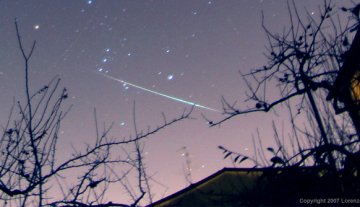Best Meteor Shower of 2007 Peaks Dec. 13


What could be the best meteor display of the year will reach its peak on the night of Dec.13-14.
Here is what astronomers David Levy and Stephen Edberg have written of the annual Geminid Meteor Shower: "If you have not seen a mighty Geminid fireball arcing gracefully across an expanse of sky, then you have not seen a meteor."
The Geminids get their name from the constellation of Gemini, the Twins, because the meteors appear to emanate from a spot in the sky near the bright star Castor in Gemini.
Also in Gemini this month is the planet Mars, nearing a close approach to the Earth later this month, and shining brilliantly with yellow-orange hue. To be sure, Mars is certain to attract the attention of prospective Geminid watchers this upcoming week.
The Geminids begin to appear noticeably more numerous in the hours after 10 p.m. local time, because the shower's radiant is already fairly high in the eastern sky by then. The best views, however, come around 2 a.m., when their radiant point will be passing very nearly overhead.
The higher a shower's radiant, the more meteors it produces all over the sky.


What could be the best meteor display of the year will reach its peak on the night of Dec.13-14.
Here is what astronomers David Levy and Stephen Edberg have written of the annual Geminid Meteor Shower: "If you have not seen a mighty Geminid fireball arcing gracefully across an expanse of sky, then you have not seen a meteor."
The Geminids get their name from the constellation of Gemini, the Twins, because the meteors appear to emanate from a spot in the sky near the bright star Castor in Gemini.
Also in Gemini this month is the planet Mars, nearing a close approach to the Earth later this month, and shining brilliantly with yellow-orange hue. To be sure, Mars is certain to attract the attention of prospective Geminid watchers this upcoming week.
The Geminids begin to appear noticeably more numerous in the hours after 10 p.m. local time, because the shower's radiant is already fairly high in the eastern sky by then. The best views, however, come around 2 a.m., when their radiant point will be passing very nearly overhead.
The higher a shower's radiant, the more meteors it produces all over the sky.







 mas o céu está cada vez com mais nuvens altas o que dificulta muito as coisas para alem da luz artificial.
mas o céu está cada vez com mais nuvens altas o que dificulta muito as coisas para alem da luz artificial.
